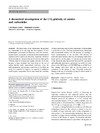Identificador persistente para citar o vincular este elemento:
https://accedacris.ulpgc.es/jspui/handle/10553/75163
| Campo DC | Valor | idioma |
|---|---|---|
| dc.contributor.author | Azofra Mesa, Luis Miguel | - |
| dc.contributor.author | Altarsha, Muhannad | - |
| dc.contributor.author | Ruiz-López, Manuel F. | - |
| dc.contributor.author | Ingrosso, Francesca | - |
| dc.date.accessioned | 2020-11-03T10:58:00Z | - |
| dc.date.available | 2020-11-03T10:58:00Z | - |
| dc.date.issued | 2013 | - |
| dc.identifier.issn | 1432-881X | - |
| dc.identifier.uri | https://accedacris.ulpgc.es/handle/10553/75163 | - |
| dc.description.abstract | The knowledge of the interactions taking place at a molecular level can help the development of new technological procedures in Chemistry with low environmental impact. In organic, biochemical and pharmaceutical synthesis and in analytical chemistry, important advances in this domain are related to the use of solvents that can be valid alternatives to hazardous organic solvents. In the last decades, a large emphasis has been given to the use of carbon dioxide under supercritical conditions, since the mild temperature and pressure conditions of the fluid can easily be controlled to improve its capacity to solubilize small organic compounds. On the other hand, the solubility of larger molecules and of polar compounds in this medium is generally very low. This has motivated recent theoretical and experimental studies with the purpose of reaching a better understanding of the so-called CO2-philicity of molecules and materials, and very encouraging results have been reported. In this paper, we present an ab initio study of the intermolecular interactions between CO2 and amide and carbamide derivatives, performed on model 1:1 complexes at the MP2/aug-cc-pVTZ//MP2/aug-cc-pVDZ level. Our findings shed some light on the key points to be considered in the design of large CO2-philic molecules, hinting at the use of solubilizer groups in which amide or urea bonds could be involved. | - |
| dc.language | eng | - |
| dc.relation.ispartof | Theoretical Chemistry Accounts | - |
| dc.source | Theoretical Chemistry Accounts [ISSN 1432-881X], v. 132, 1326 | - |
| dc.subject | 2307 Química física | - |
| dc.subject.other | Supercritical CO2 | - |
| dc.subject.other | Amide | - |
| dc.subject.other | Urea | - |
| dc.subject.other | CO2-philic compounds | - |
| dc.subject.other | Lewis acid/base interaction | - |
| dc.subject.other | Ab initio calculations | - |
| dc.title | A theoretical investigation of the CO2-philicity of amides and carbamides | - |
| dc.type | info:eu-repo/semantics/article | - |
| dc.type | Article | - |
| dc.identifier.doi | 10.1007/s00214-012-1326-4 | - |
| dc.identifier.issue | 4 | - |
| dc.relation.volume | 132 | - |
| dc.investigacion | Ciencias | - |
| dc.type2 | Artículo | - |
| dc.description.numberofpages | 9 | - |
| dc.identifier.ulpgc | No | - |
| dc.description.sjr | 0,763 | |
| dc.description.jcr | 2,143 | |
| dc.description.sjrq | Q2 | |
| dc.description.jcrq | Q3 | |
| dc.description.scie | SCIE | |
| item.fulltext | Con texto completo | - |
| item.grantfulltext | open | - |
| crisitem.author.dept | GIR IUNAT: Fotocatálisis y espectroscopía para aplicaciones medioambientales. | - |
| crisitem.author.dept | IU de Estudios Ambientales y Recursos Naturales | - |
| crisitem.author.orcid | 0000-0003-4974-1670 | - |
| crisitem.author.parentorg | IU de Estudios Ambientales y Recursos Naturales | - |
| crisitem.author.fullName | Azofra Mesa, Luis Miguel | - |
| Colección: | Artículos | |
Citas de WEB OF SCIENCETM
Citations
31
actualizado el 12-ene-2026
Visitas 10
271
actualizado el 15-ene-2026
Descargas
390
actualizado el 15-ene-2026
Google ScholarTM
Verifica
Altmetric
Comparte
Exporta metadatos
Los elementos en ULPGC accedaCRIS están protegidos por derechos de autor con todos los derechos reservados, a menos que se indique lo contrario.
